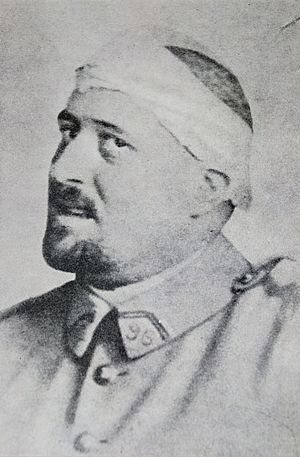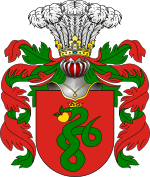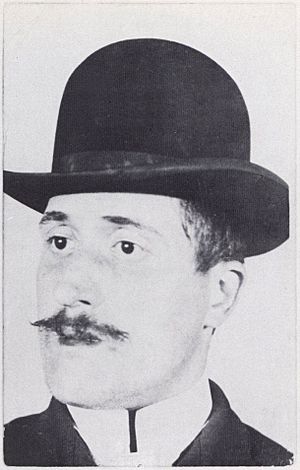Guillaume Apollinaire facts for kids
Quick facts for kids
Guillaume Apollinaire
|
|
|---|---|

Photograph of Guillaume Apollinaire in spring 1916 after a shrapnel wound to his temple
|
|
| Born | Wilhelm Albert Włodzimierz Apolinary Kostrowicki 26 August 1880 Rome, Italy |
| Died | 9 November 1918 (aged 38) Paris, France |
| Occupation | Poet, writer, art critic |
| Signature | |
Guillaume Apollinaire ( 26 August 1880 – 9 November 1918) was a French poet, playwright, short story writer, novelist, and art critic of Polish-Belarusian descent.
Apollinaire is considered one of the foremost poets of the early 20th century, as well as one of the most impassioned defenders of Cubism and a forefather of Surrealism. He is credited with coining the term "cubism" in 1911 to describe the emerging art movement and the term "surrealism" in 1917 to describe the works of Erik Satie. The term Orphism (1912) is also his. Apollinaire wrote one of the earliest Surrealist literary works, the play [Les mamelles de Tirésias]] (1917).
Apollinaire was active as a journalist and art critic for Le Matin, L'Intransigeant, L'Esprit nouveau, Mercure de France, and Paris Journal. In 1912 Apollinaire cofounded Les Soirées de Paris, an artistic and literary magazine.
Two years after being wounded in World War I, Apollinaire died in the Spanish flu pandemic of 1918; he was 38.
Contents
Life
Wilhelm Albert Włodzimierz Apolinary Kostrowicki was born in Rome, Italy, and was raised speaking French, Italian, and Polish. He emigrated to France in his late teens and adopted the name Guillaume Apollinaire. His mother, born Angelika Kostrowicka, was a Polish noblewoman born near Navahrudak, Grodno Governorate (present-day Belarus). His maternal grandfather was a general in the Russian Imperial Army who was killed in the Crimean War. Apollinaire's father is unknown but may have been Francesco Costantino Camillo Flugi d'Aspermont (born 1835), a Graubünden aristocrat who disappeared early from Apollinaire's life. Francesco Flugi von Aspermont was a nephew of Conradin Flugi d'Aspermont (1787–1874), a poet who wrote in ladin putèr (an official language dialect of Switzerland spoken in Engiadina ota), and perhaps also of the Minnesänger Oswald von Wolkenstein (born c. 1377, died 2 August 1445; see Les ancêtres Grisons du poète Guillaume Apollinaire at Généanet).
Apollinaire eventually moved from Rome to Paris and became one of the most popular members of the artistic community of Paris (both in Montmartre and Montparnasse). His friends and collaborators in that period included Pablo Picasso, Henri Rousseau, Gertrude Stein, Max Jacob, André Salmon, André Breton, André Derain, Faik Konitza, Blaise Cendrars, Pierre Reverdy, Alexandra Exter, Jean Cocteau, Erik Satie, Ossip Zadkine, Marc Chagall, Marcel Duchamp and Jean Metzinger. He became romantically involved with Marie Laurencin, who is often identified as his muse. While there, he dabbled in anarchism and spoke out as a Dreyfusard in defense of Dreyfus's innocence.
In late 1909 or early 1910, Metzinger painted a Cubist portrait of Apollinaire. In his Vie anecdotique (16 October 1911), the poet proudly writes: "I am honoured to be the first model of a Cubist painter, Jean Metzinger, for a portrait exhibited in 1910 at the Salon des Indépendants." It was not only the first Cubist portrait, according to Apollinaire, but it was also the first great portrait of the poet exhibited in public, prior to others by Louis Marcoussis, Amedeo Modigliani, Mikhail Larionov and Picasso.
In 1911 he joined the Puteaux Group, a branch of the Cubist movement soon to be known as the Section d'Or. The opening address of the 1912 Salon de la Section d'Or—the most important pre-World War I Cubist exhibition—was given by Apollinaire.
On 7 September 1911, police arrested and jailed him on suspicion of aiding and abetting the theft of the Mona Lisa and a number of Egyptian statuettes from the Louvre, but released him a week later. The theft of the statues was committed by a former secretary of Apollinaire, Honoré Joseph Géry Pieret, who had returned one of the stolen statues to the French newspaper the Paris-Journal. Apollinaire implicated his friend Picasso, who was also brought in for questioning in the theft of the Mona Lisa, but he was also exonerated. The theft of the Mona Lisa was perpetrated by Vincenzo Peruggia, an Italian house painter who acted alone and was only caught two years later when he tried to sell the painting in Florence.
World War I
Apollinaire fought in World War I and, in 1916, received a serious shrapnel wound to the temple, from which he would never fully recover. He wrote Les Mamelles de Tirésias while recovering from this wound. During this period he coined the word "Surrealism" in the programme notes for Jean Cocteau's and Erik Satie's ballet Parade, first performed on 18 May 1917. He also published an artistic manifesto, L'Esprit nouveau et les poètes. Apollinaire's status as a literary critic is most famous and influential in his recognition of the Marquis de Sade, whose works were for a long time obscure, yet arising in popularity as an influence upon the Dada and Surrealist art movements going on in Montparnasse at the beginning of the twentieth century as, "The freest spirit that ever existed."
The war-weakened Apollinaire died of influenza during the Spanish flu pandemic of 1918. He was interred in the Père Lachaise Cemetery, Paris.
In popular culture
Apollinaire is played by Seth Gabel in the 2018 television series Genius, which focuses on the life and work of Pablo Picasso.
Poetry
- L'enchanteur pourrissant (1909). The Enchanter Rotting
- Le Bestiaire ou Cortège d'Orphée (1911)
- Alcools (1913)
- Vitam impendere amori (1917)
- Calligrammes, poèmes de la paix et de la guerre 1913–1916 (1918) (published shortly after Apollinaire's death)
- Il y a... (1925) Albert Messein
- Julie ou la rose (1927)
- Ombre de mon amour (1947). Poems addressed to Louise de Coligny-Châtillon
- Poèmes secrets à Madeleine (1949). Pirated edition
- Le Guetteur mélancolique (1952). Previously unpublished works
- Poèmes à Lou (1955)
- Soldes (1985). Previously unpublished works
- Et moi aussi je suis peintre (2006). Album of drawings for Calligrammes, from a private collection
Novels
- Mirely ou le Petit Trou pas cher (1900). Mirely, or The Cheap Little Hole (unpublished)
- Que faire ? (1900). What to Do?
- Les Onze Mille Verges ou les Amours d'un hospodar (1907). The Eleven Thousand Rods
- Les Exploits d'un jeune Don Juan (1911). The Amorous Exploits of a Young Rakehell, trans. Reaves Tessor (1959)
- La Rome des Borgia (1914). The Rome of the Borgias
- La Fin de Babylone (1914). The Fall of Babylon
- Les Trois Don Juan (1915). The Three Don Juans
- La Femme assise (1920). The Sitting Woman
Short story collections
- L'Hérèsiarque et Cie (1910). The Heresiarch and Co., trans. Rémy Inglis Hall (1965)
- Le Poète assassiné (1916). The Poet Assassinated, trans. Matthew Josephson (1923, title story); trans. Ron Padgett (1968, unabridged)
- Les Épingles (1928). The Pins
Plays
- Les Mamelles de Tirésias (1917).
- La Bréhatine (1917). Screenplay (collaboration with André Billy)
- Couleurs du temps (1918)
- Casanova (published 1952)
Articles
- Le Théâtre italien, illustrated encyclopedia, 1910
- Preface, Catalogue of 8th Salon annuel du Cercle d'art Les Indépendants, Musée moderne de Bruxelles, 10 June – 3 July 1911.
- La Vie anecdotique, Chroniques dans Le Mercure de France, 1911–1918
- Pages d'histoire, chronique des grands siècles de France, chronicles, 1912
- Les Peintres Cubistes, Méditations Esthétiques, 1913
- La Peinture moderne, 1913
- L'Antitradition futuriste, manifeste synthèse, 1913
- Jean Metzinger à la Galerie Weill, Chroniques d'art de Guillaume Apollinaire, L'Intransigeant, Paris Journal, 27 May 1914
- Case d'Armons, 1915
- L'esprit nouveau et les poètes, 1918
- Le Flâneur des Deux Rives, chronicles, 1918
Translations into English
- The Poet Assassinated, trans. Matthew Josephson (The Broom Publishing, 1923)
- Selected Writings, trans. Roger Shattuck (New Directions, 1948)
- Alcools: Poems 1898-1913, trans. Walter Meredith (Doubleday, 1964)
- Alcools, trans. Anne Hyde Greet (University of California Press, 1965)
- Selected Poems, trans. Oliver Bernard (Penguin, 1965; expanded, bilingual edition, Anvil Press, 1986)
- The Heresiarch and Co., trans. Rémy Inglis Hall (1965), published in the UK as The Wandering Jew and Other Stories (1967)
- The Poet Assassinated, trans. Ron Padgett (Holt, Rinehart & Winston, 1968)
- Calligrams, trans. Anne Hyde Greet (Unicorn Press, 1970)
- Apollinaire on Art: Essays and Reviews, 1902-1918, trans. Susan Suleiman (1972)
- Zone, trans. Samuel Beckett (Dolmen Press, 1972)
- The Self-Dismembered Man: Selected Later Poems, trans. Donald Revell (Wesleyan University Press, 2004)
- Alcools: Poems, trans. Donald Revell (Wesleyan University Press, 2011)
- The Little Auto, trans. Beverley Bie Brahic (CB editions, 2012)
- "Zone", trans. David Lehman, in Virginia Quarterly Review (2013)
- Zone: Selected Poems, trans. Ron Padgett (New York Review Books, 2015)
- Selected Poems, trans. Martin Sorrell (Oxford University Press, 2015)
See also
 In Spanish: Guillaume Apollinaire para niños
In Spanish: Guillaume Apollinaire para niños
- La Chanson du mal-aimé, oratorio by Léo Ferré on Apollinaire's eponymous poem (from Alcools)
- Monostich
- Prix Guillaume Apollinaire
Images for kids
-
Muse Inspiring the Poet. Portrait of Apollinaire and Marie Laurencin, by Henri Rousseau, 1909
-
Jean Metzinger, 1911, Étude pour le portrait de Guillaume Apollinaire, graphite on paper, 48 × 31.2 cm, Musée National d'Art Moderne, Centre Georges Pompidou, Paris









